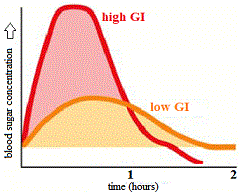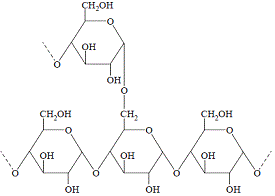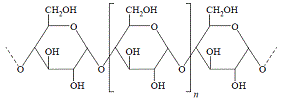Glycaemic Index (GI) Chemistry Tutorial
Key Concepts
- Glycaemic index (or glycemic index) is often abbrevated as GI.
- Digestion of food containing carbohydrates produces glucose which enters the blood.
⚛ Glucose in the blood is known as "blood sugar".
- Glycaemic index (GI) is a way of measuring the effects of food on blood sugar levels.
⚛ Slower rate of digestion of carbohydrate generally results in food with a lower glycaemic index.
⚛ Faster rate of digestion of carbohydrate generally results in food with a higher glycaemic index.
- The glycaemic effect of foods is dependent on such factors as:
⚛ type of starch (amylose versus amylopectin) in the food
⚛ physical entrapment of the starch molecules within the food
⚛ fat and protein content of the food
⚛ presence of organic acids or their salts in the meal
- Glycaemic index does not measure the production of insulin as a result of increases in blood sugar.
Two foods may have the same glycaemic index but produce different amounts of insulin in the body.
- Frequent overproduction of insulin may result in type 2 diabetes, an insensitivity to insulin which requires increasingly greater amounts of insulin in order to regulate the concentration of glucose in blood.
Type 1 diabetes results when the pancreas can not produce enough insulin to regulate the concentration of glucose in the blood.
Please do not block ads on this website.
No ads = no money for us = no free stuff for you!
Measuring Glycaemic Index of Food
Different people digest food at different rates.
The same person will digest food at different rates on different days, or even at different times of the same day.
So, we need to use a number of different people to conduct experiments to determine some sort of "average" glycaemic index for a food.
10 human beings are usually used.
These people are required to fast for 12 hours (usually overnight) before taking part in the experiment.
Then they are given a sample of the test food to eat which contains 50 grams of available carbohydrate (known as glycaemic carbohydrate, often estimated as total mass of carbohydrate minus the mass of dietary fibre, cellulose).
Blood samples, say 150 μL obtained by a finger-prick with a lancet, are taken from each person at regular intervals over a 2 hour period immediately following their ingestion of the test food.
For example, blood samples might be drawn at 15, 30, 45, 60, 90 and 120 minutes.
The concentration of glucose in each blood sample is determined.
Plotting the results as a graph produces a glycaemic response curve for each person for the test food.
The area under the curve of this glycaemic response curve for each person is divided by the area under the curve for a standard (glucose or white bread are commonly used as standard foods) and then multiplied by 100.
| GI = |
area under curve for test food
area under curve for standard food |
× 100 |
The average GI value is then determined by adding together all 10 GI values calculated above and dividing the total by 10.
Typical values for the glycaemic index of some foods is given in the tables below:
| Grains |
Dairy Products |
Bread |
|---|
| Food |
GI |
Food |
GI |
Food |
GI |
|---|
| bulgur |
48 |
skim milk |
32 |
pumpernickel bread |
56 |
| brown rice |
50 |
reduced-fat yoghurt |
33 |
hamburger bun |
61 |
| quinoa |
53 |
premium ice-cream |
38 |
pita bread |
68 |
| sweet corn on the cob |
60 |
full fat milk |
41 |
white bread |
71 |
| white rice |
89 |
regular ice-cream |
57 |
whole wheat bread |
71 |
| Pasta |
Vegetables |
Fruit |
|---|
| Food |
GI |
Food |
GI |
Food |
GI |
|---|
| fettucini |
32 |
carrots |
35 |
pear |
38 |
| wholemeal spaghetti (al dente) |
42 |
green peas |
51 |
apple |
39 |
| white spaghetti (al dente) |
46 |
boiled white potato |
82 |
orange |
40 |
| macaroni (al dente) |
47 |
instant mashed potato |
87 |
ripe banana |
62 |
| overcooked white spaghetti |
58 |
baked russet potato |
111 |
watermelon |
72 |
Foods can then be roughly categorised as "high", "medium" and "low" GI foods.
| GI |
< 56 |
56 - 69 |
> 69 |
| category |
low |
medium |
high |
| Examples |
most vegetables most fruits seeds whole grains |
sucrose raisins prunes banana sweet potato |
glucose white bread white rice corn flakes |
Glucose is a food with a high glycaemic index, 100, because it does not need to be broken down during digestion and can be absorbed straight into the blood.
Cooked white rice is a high GI food, GI ≈ 89
This means that eating 50 grams of carbohydrate in the form of cooked white rice will increase blood sugar levels to 89% compared to ingesting 50 grams of glucose.
Full fat milk is a low GI food, GI ≈ 41
Ingesting 50 grams of carbohydrate in the form of milk will increase blood sugar levels to only 41% compared to ingesting 50 grams of glucose.
The diagram below shows a graph of the change in blood sugar concentration over time for a high GI food and a low GI food:

Notice how the concentration of blood sugar (glucose) increases rapidly to a maximum when a high GI food is ingested compared with the more gradual and sustained increase in blood sugar concentration when a low GI food is ingested.
Effect of Type of Starch on Glycaemic Index of Food
Starch is a carbohydrate found in many foods.
Starch is composed of varying amounts of 2 different polysaccharides: amylopectin and amylose.
Both amylopectin and amylose are polymers made up of many glucose units joined together by glycosidic links, -C-O-C-, also known as ether bonds.
During digestion, both amylopectin and amylose hydrolyse, that is they react with water which causes the glycosidic links to break resulting in the production of many glucose molecules.
But amylopectin and amylose differ in the arrangment of those glucose units within the structure of the polymer, and hence in the rate at which they release glucose into our blood.
| Name |
Structure |
Description |
Rate of Digestion |
|---|
| amylopectin |
 |
Branched
Open structure |
Easier to digest
Faster rate of digestion |
| amylose |
 |
Unbranched
Linear structure |
Harder to digest
Slower rate of digestion |
A food that contains a high proportion of amylopectin and a low proportion of amylose will be easy to digest due to the open, branched-chain structure of amylopectin, so the rate of digestion will be greater.
Glucose will be released into the blood quickly.
This food will have a high glycaemic index (high GI).
A food that contains a high proportion of amylose and a low proportion of amylopectin will be harder to digest due to the linear, unbranched-chain structure of amylose, so the rate of digestion will be lower.
Glucose will be released into the blood more slowly.
This food will have a lower glycaemic index (lower GI).
| relative GI |
% amylopectin |
% amylose |
|---|
| low GI |
low |
high |
| high GI |
high |
low |
Effect of Physical Entrapment and Food Processing on Glycaemic Index
Whole grain wheat contains a wheat kernel comprosed of starch inside a coating called bran.
The starch is enclosed, physically entrapped, within a tough bran shell.
The presence of this shell of bran around the starch means the enzymes your body uses to hydrolyse the starch can't access the starch easily, so digestion of the starch is slower, the release of glucose into your blood is slower, so the glycaemic index of whole grain wheat is low (low GI).
When we process this whole grain wheat by milling it, we grind it which removes the bran coating and exposes the starch of the wheat kernel.
We can produce a very fine flour in this way, that is, the particles of "flour" are small and of more uniform size.
Since the surface area of the particles has increased, the rate at which digestive enzymes can act on the exposed starch increases so the concentration of glucose in blood rapidly increases when we ingest this fine flour.
The glycaemic index of highly processed "white flour" is higher than for whole grain wheat (high GI).
How we process food by cooking it also effects its glycaemic index.
Overcooking pasta for example, results in the breakdown of some of the carbohydrate and fibre even before you eat it.
Once ingested, the rate of digestion of this overcooked pasta will be greater than if the pasta had been cooked until "al dente" (just cooked enough).
Overcooked pasta thus has a higher glycaemic index (higher GI) than al dente pasta.
Presence of Other Nutrients on Glycaemic Index
The food we eat is typically composed of carbohydrates, proteins and triglycerides (fats and oils).
Proteins and triglycerides (fats and oils) require a longer time to digest than starch.
The presence of proteins, fats and oils in a meal will slow down how fast your stomach contents are emptied into your small intestine, and hence, they slow down the rate at which glucose from digested starch in the meal will reach your blood.
Food with a higher proportion of protein and/or fat compared to carbohydrate is more likely to have a lower glycaemic index than food with a lower proportion of protein and/or fat content.
Icecream, for instance, has a high proportion of fat so it can have quite a low glycaemic index (about 37).
Similarly, the presence of organic acids such as vinegar for example, or the salts of organic acids, monosodium glutamate (MSG) for example, will slow down the digestive process and therefore the glucose released from the digestion of carbohydrate will be released into the blood more slowly.
The glycaemic index of these foods will be lower.
Calculating the Glycaemic Index of a Meal
1 cup of instant mashed potato (GI = 87) provides you with 30 grams of glycaemic carbohydrate.
½ cup of corn (GI = 60) provides you with 15 grams of glycaemic carbohydrate.
If you eat these together as a meal, what would be the glycaemic index of your meal?
total glycaemic carbohydrate in the "meal" = 30 g + 15 g = 45 g
percentage of glycaemic carbohydrate due to instant mashed potato = (30 g ÷ 45 g) × 100 = 67%
percentage of glycaemic carbohydrate due to corn = (15 g ÷ 45 g) × 100 = 33%
contribution of mashed potato to "meal" = %carbohydrate/100 × GI = 67/100 × 87 = 58
contribution of corn to "meal" = %carbohydrate/100 × GI = 33/100 × 60 = 20
Glycaemic index of "meal" = contribution of potato + contribution of corn = 58 + 20 = 78



